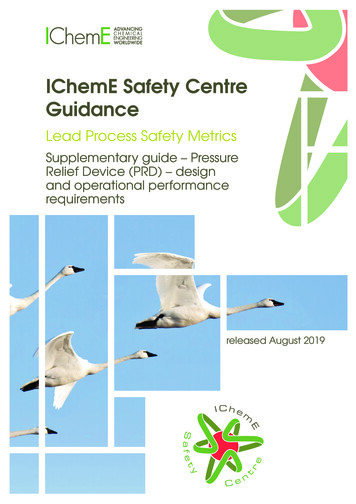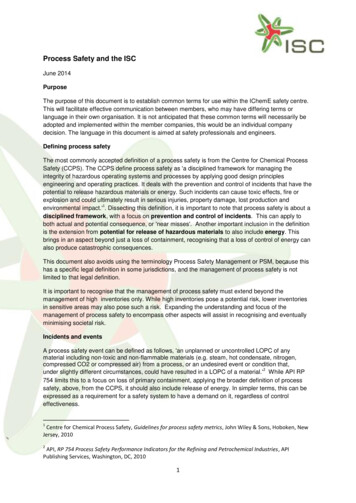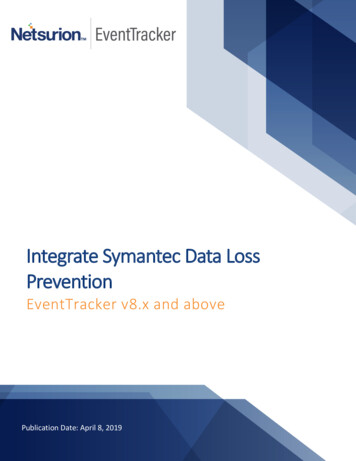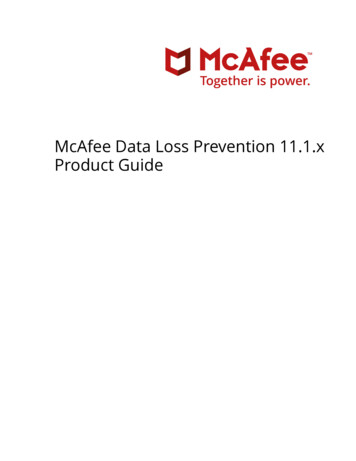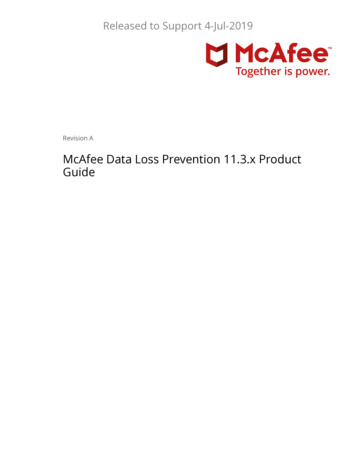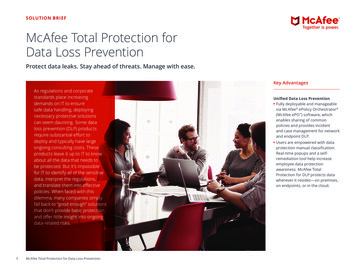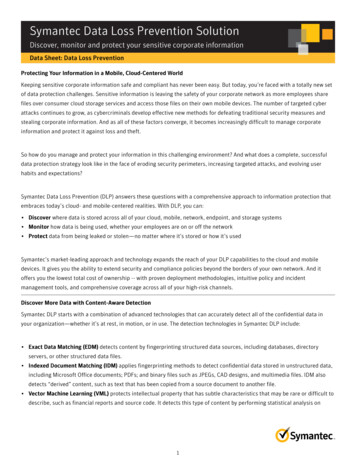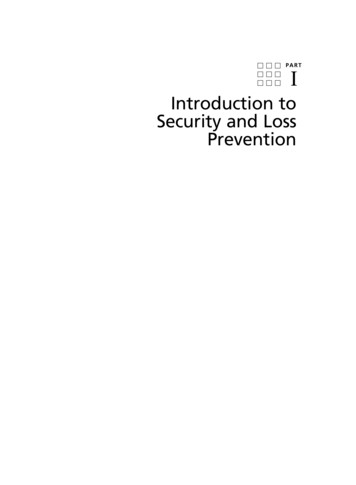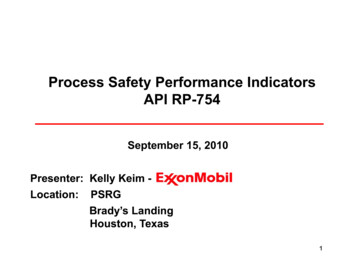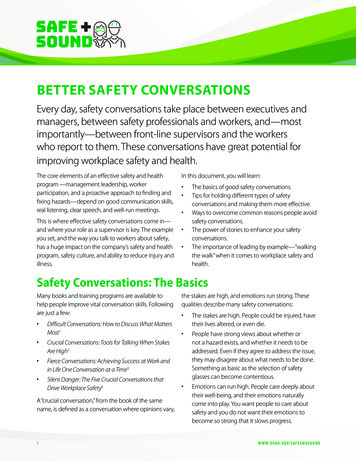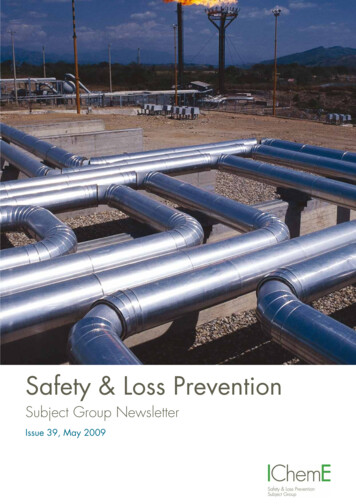
Transcription
Safety & Loss PreventionSubject Group NewsletterIssue 39, May 2009
News from the IChemE Safety & Loss Prevention Subject GroupSafety & Loss PreventionSubject Group NewsletterIssue 39, May 2009Editor: Dr John Bond, email: pEditorial1Energy Safety:New Challenges1Design and Siting ofProcess Plant Buildings1Learning from Accidents.EPSC Conference in Antwerp4Department of Work and Pensions4Developments on the HSE Web Site4OECD Web Site5The Black Hole5Loss Prevention Bulletin6Process Safety &Environmental Protection6Crossword Puzzle No.287Diary9
Safety & Loss Prevention NewsletterIssue 38 May 2009, Page 1EDITORIALDESIGN AND SITING OF PROCESS PLANTBUILDINGSEPSC and OPERA arranged a very interesting meeting“An Audience with Andrew Hopkins” on the 23 March 2009.This meeting was about the lessons to be learnt from theTexas City Refinery fire. Andrew gave his own, sometimescontroversial, views about the causes which went to thetop of the company. In particular he expressed the viewthat there had to be more emphasis on rule complianceand less on risk management. A contrary view was givenby Peter Webb. Andrew Hopkins has written a book“Failure to Learn” which is not yet available on the internetbut I have borrowed a copy and will write a review in duecourse. I suspect that the debate on rule complianceversus risk management will go on for awhile.This conference was held as a joint meeting of theS&LPSG of the IChemE with FABIG and EPSC on the on“Design and Siting of Process Plant Buildings”, held on the4th of December 2008.The first speaker was Wilbert Lee of Chevron (USA). TheAPI RP-753: “Management of Hazards Associated withLocation of Process Plant Portable Buildings” is concernedwith the management of risks associated with the locationof portable buildings on process plant and the reduction ofrisks to the occupants. The guidance covers the hazardsof explosion, fire and toxic materials. The standardsupersedes API RP-752.The USA OSHA and CSB concerns and issues coversbetter guidance for use of portable buildings, occupancynumbers, location of non-essential personnel, the minimumsafe distances and simplified methodENERGY SAFETY: NEW CHALLENGES MEETING:UCL 9TH JAN 09This highly successful one day meeting organised byIChemE Safety & Loss Prevention Subject Group focusedon the safety challenges associated with the quest for newforms of energy. Speakers covered a diverse range of topicspanning carbon capture and sequestration, nanotechnology, fuel cells to biofuels. Dr Steffi Friedrichs ofNanotechnology Industries Association provided a SWOTanalysis of the nano-materials in the energy sector, theperceived risks highlighting the lack of established testingprotocols for assessing such risks. State of the art CFDmodelling work on hydrogen combustion and explosionwith particular reference to fuel cells was presented byProfessor Jennifer Wen, Kingston University. The meetingorganiser, Professor Mahgerefteh of UCL ChemicalEngineering discussed some of the urgent challengesassociated with the safe transportation of CO2. Addressingsuch issues is considered as key to the success of CCS.Professor Bahaman Tohidi, Director of Centre for GasHydrate Research at Heriot-Watt University presented theresults of his research on the role of naturally occurringhydrates as an effective barrier against the escape of CO2from subsea storage sites. The production of biofuels hasundergone a seven fold increase in the past 4 years.Janet Etchells of HSE reviewed some of the main hazardsand HSE guidelines regarding their safe production anduse.The API RP-753: Guiding Principles covers location ofpersonnel away from hazards, minimizing the use ofportable buildings near process areas and managingoccupancy during high risk operations. The design,construction, and installation of buildings to protectoccupants and management system for portable buildingsThe key items of API RP 753 covered occupied portablebuildings only for offices, change houses and maintenanceshops. Other examples in RP covers building not intendedfor occupancy. There was no occupancy screening andthe blast capacity for light wood trailers was.0.6 psi max. for 2A Damage, (localized damage).0.9 psi max for 2B Damage, (widespread damage, butno structural collapse)The API RP-753: key items were more simplified methoddeveloped with 3 blast zones based on plant layout andsize and can be used for siting of light wood trailers. Therewere exclusion zone and safe distance for wood trailersand limitations of non-essential personnel locations. Detailexplosion analysis could be consequence or risk based.1
Safety & Loss Prevention NewsletterIssue 38 May 2009, Page 2on BP Sites”. He started with a historical background tothe problem from 1950s to 2008 and covered buildingsiting, occupancy, drivers, and plant operations. Exampleswere given of accidents with fatalities in buildings fromFlixborough to a 1987 refinery incident. From 1990s and2000s there was explosion modelling, better understandingof physics of vapour cloud explosion, dynamic structuralanalysis/ design with PC based programs being available.By 1998 /2003 there was CIA Guidance with locationspecific blast design criteria replaced by prescriptive blastloading. It described Risk based and Hazard basedmethodologies and covered all permanent buildings notjust Control Rooms. I covered explosions, fires and toxicreleases. API 752 was first issued in 1995 and the 2ndedition in 2003. The scope is similar to CIA document“Process Plant Hazard and Control Building design”The second speaker was Andrew Crerand of Shell GlobalSolutions (UK) who spoke on “Risk-Based Approach toSiting of Portable Buildings”. He started by outlining thebackground to explosion modelling, the development ofrisk based tool and the application of the risk based tool.The system was based Shell Explosion modelling givingthe overpressure generated and the impulse prediction.The Congestion assessment method found that onecorrelation (plus another for the roofed case) hascorrelated all the relevant experimental data for sourceoverpressure. The formulation for source radius andpressure decay was still valid but it was important to takeaccount “obstacle complexity”. Many of the non-idealaspects of real plant can be allowed for. The run timeswere less than 1 second and the results were a reliablescreening tool.After the Texas Refinery incident there was an urgentrecommendations to API 752 task Force to revise therecommended practice or issue a new practice to ensuresafe placement of occupied trailers and similar temporarystructures away from hazardous areas of process plants.We issued a safety alert to your membership to takeprompt action to ensure the safe placement of occupiedtrailers away from hazardous areas of process plants.In BP there was different approach with the same Goal.There was to be “No harm to people”. Portable buildingswere sited in zoned and restricted places. New permanentbuildings had no restrictions on location but design isspecified to protect occupants from hazards which couldarise at location of building. With existing buildings thegoal is to protect occupants of all existing buildings fromHazards. There was a risk based prioritisation towardsachieving the goal.Method for determining the probability of exceeding acertain overpressure at a given location was important. Ifused for “Critical” areas where a worse-case explosion wasused it would otherwise be unrealistic and intolerable.The sustainable pressure for the building was dictated bystructural strength. For a full exceedence methodextensive information would be required. A GenericExceedence methodology was found in Shepherd softwareand comparison with API RP752 generic frequencies ofmajor explosions (350 mbar assumed) were satisfactoryHe concluded that scientific understanding of gasexplosions has greatly improved in the last 20 years withrisk based methods now existed for occupied buildings,facility siting and safety management. Validated softwaretools are becoming availableThe forth speaker was Dirk Roosendans of TotalPetrochemicals “Siting Design and Protection of OccupiedBuildings at Total Petrochemicals”. He described thebuilding siting principles with layers of protection analysis,risk assessment criteria, QRA Tool in Total Petrochemicalsthe output of QRA tool and the validation of the tool. Theessential features were prevention, mitigation andprotection.The third speaker was Kieran Glynn of BP “DevelopingGuidance for Siting and Design of Process Plant BuildingsDetails were given of the Assessment Criteria for individualScenarios and Criteria for QRA giving rise to the risk2
Safety & Loss Prevention NewsletterIssue 38 May 2009, Page 3contours for individual loads and the societal risk. Theinput data was described for the QRA Tool includingignition source and scenario models. Modelling of thephysical effects of confinement and congestion, thevulnerability of blast overpressure and heat radiation, theresistance of materials, contours with the accidentalloadings were used in the validation of the QRA. Thisresulted in the principles and inherent safe designobtained. The system was also applied to design of allequipment.with the recent trend in the process risk analysis worldparticularly with off site and on site risk. Risk analysis hadto be used to optimise design and hence save money.Offshore QRA linked risks to people with risks to assets.Building risk assessment was integral to explosion and fireanalysis and had to be fed into QRA. On-shore riskanalysis was more variable being less conservative withon-site risks. The software approaches were now gearedto design input and more focused on explosion than fire.They were much more variable than offshore risk analysiswith no consensus. The BLAST and PHAST risk softwarewere similar and used generic failure cases and leakfrequency with similar other details. They were broughttogether in the risk model for people, assets and buildings.The fifth speaker was Max Kolbe of Baker Risk (USA)“Master Planning for Companies Performing Siting Studies& QRA’s” He described the work of the company indeveloping Master Planning for Companies with FacilitySiting Studies (FSS) and QRA with the methodologies andtest data used. They had carried out unique testingprograms in the area of large scale VCEs on structuralimpact analyses. They had a global approach to FSS andQRA to identify individual scenarios to establish thedominant causes, consequences or risks across thecompany’s assets. The lessons learned were:-The seventh speaker was Paul Summers of MMIEngineering (USA) “Design of Modular Blast-ResistantBuildings for Petrochemical Facilities”. The ASCE TaskCommittee on blast design was now used through industryin the USA for the design of buildings to resist vapour cloudexplosions at refineries and petrochemical plants. Controlrooms and operator shelters were covered with modularbuildings covered in the 2008 edition. The motivation fortheir use is clear but most can be removed from the site.The design approach included the blast load predictionbased on cloud characteristics (fuel, size, concentration),ignition (location, strength), confinement (degree and size),and congestion, selection of appropriate performancecriteria, loading analysis giving rise to the design of themembers and foundations. Three levels, low, medium andhigh damage levels of response are thus obtained.Probable projectile impact analysis is considered fromdifferent types of projectiles.take a global approachdefine study methodologies and criteria of interesttest the methodology on a pilot scalerefine study results if initial conservative assumptionsresult in high levels of expenditure (e.g., buildingupgrades)after applying consequence analysis, consider riskanalysisadd all buildings to a databaseThe final speaker was Ken Patterson of Yule Catto “CIAGuidance Protection of People on Chemical ManufacturingSites”. A detailed account of the explosion at Hickson andWelch was given and its effect on a building. TheChemical Industry Association had been central in devisinga standard and guidance for the design of buildings onchemical plants in the UK and he gave a detailed accountof the method adopted. Finally he reminded people thatthe real risks had to be assessed but it was best to get asmany of the staff off the site, concentrate on the areas ofgreatest risk but remember the buildings are secondaryand the primary aim is safe operationidentify all release cases that dominate risksort database globally, country or site specific toidentify where best to spend funds to drive down risks.link the management of change process to masterplanningdirectionally, drive sites to lower risks (can be 5-10years)The sixth speaker was Jeff Daycock of, DNV Energy “RiskBased Design Methodologies: Limitations and FutureDevelopments”. He thought that there were exciting times3
Safety & Loss Prevention NewsletterIssue 38 May 2009, Page 4The Act raises the maximum penalties that can be imposedfor breaching health and safety regulations in the lowercourts from 5,000 to 20,000 and the range of offencesfor which an individual can be imprisoned has also beenbroadened.EPSC CONFERENCE, LEARNING FROMACCIDENTS, ANTWERP, 9/10 OCTOBER 2008.This event which was jointly organised by EPSC and itspartners was found on the premise that learning fromaccident is a push – pull activity. In other words so calledlearning organisations extract and push out the lessonsfrom internal incidents to the outside world as well as pullin lessons from the mishaps of others. To a large extentthis conventional wisdom was challenged throughout theconference by several speakers who asserted that a focuson internal learning from high consequence – lowprobability events provides sufficient opportunities to allowthe organization to improve its own safety performance.This then begs the questions why in the past have highhaz
API 752 was first issued in 1995 and the 2nd edition in 2003. The scope is similar to CIA document “Process Plant Hazard and Control Building design” After the Texas Refinery incident there was an urgent recommendations to API 752 task Force to revise the recommended practice or issue a new practice to ensure safe placement of occupied trailers and similar temporary structures away from .
